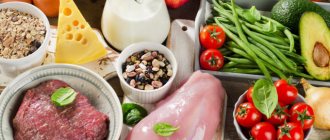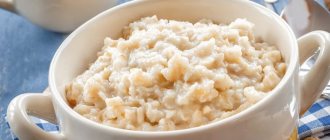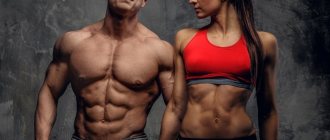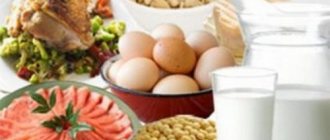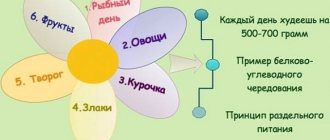The mechanism of the protein-vegetable diet
A protein-vegetable diet for weight loss is developed taking into account the daily needs of the body for the full functioning of all systems and organs.
Scientists have proven that fat deposits accumulate from unspent carbohydrates. The essence of a protein-vegetable diet is to limit the intake of carbohydrates and fats. With a reasonable alternation of protein foods with vegetables, the work of the digestive system is facilitated.
The essence of a protein-vegetable diet is to limit the intake of carbohydrates and fats.
Proteins included in the diet are necessary for the construction of the muscle frame. In the absence of external sources of lipids and carbohydrates, the body obtains energy by breaking down subcutaneous fat reserves.
The diet is based on:
- alternating protein products and vegetable products;
- moderate calorie restriction;
- excluding salt, sugar and fast carbohydrates.
You can lose weight quickly, without hunger and restrictions on taste preferences. By converting fat stored by the body into energy, weight loss is easy, with a parallel improvement in muscle relief and body contours.
Stage No. 1 “ATTACK”
The Dukan diet begins with the shortest stage - “Attack”, during which you are allowed to eat only protein. Due to too much protein load on the body, this period is limited in duration and, depending on the amount of extra pounds, the average is:
- for excess weight up to 5 kg – 1–2 days;
- 5–10 kg – 2–3 days;
- 10–20 kg – 3–5 days;
- 20–30 kg – 5–7 days;
- if you need to lose 30 kg or more in 7–10 days.
At the first stage of the diet, you must adhere to the following rules:
- Eat only protein foods.
- All products can be boiled, stewed, cooked in a slow cooker, baked, but without using oil.
- Reduce, or better yet, completely eliminate salt, replacing it with spices, herbs, and lemon juice.
- Drink at least 2 liters. water per day, including tea and coffee.
- Eat 1.5 tbsp. l. oat bran per day (if intolerant, you can replace them with the same amount of dry ground buckwheat).
To make the most of the “Attack” phase, it is recommended to follow several recommendations from Dr. Dukan, which will help the body react less stressfully to a new diet.
It is advisable to start the first stage while on vacation or before the weekend. This is due to the fact that at “Attack” many products are excluded from the menu, in particular those containing glucose. In most cases, this negatively affects well-being and performance; weakness, headaches, lethargy, bad breath, and the smell of acetone from the body may appear. Such symptoms are associated with glucose deficiency and the active breakdown of one’s own fat deposits, the remains of which give off an unpleasant odor. However, within 2-3 days these signs disappear. But during this most difficult period of the diet, it is better to stay at home.
To speed up the process of fat burning and removal of residual decay products, daily walks for half an hour are necessary. This rule must be followed during all phases of the Dukakna diet, but is especially important during the “Attack”. In addition, being in the fresh air improves your well-being and speeds up adaptation to a new diet. Drinking plenty of fluids also provides a similar effect.
At the first stage, meals should be frequent and in small portions, although there are no restrictions on the amount eaten. But at the same time it is necessary to eat only approved foods.
Authorized Products
The diet on the “Attack” can be made up of the following products:
- Meat. Beef tenderloin and lean fillet. It is allowed to eat rabbit meat and beef by-products: tongue, kidneys, liver. Chicken, turkey and pork can be consumed in the form of lean ham. The diet may include chicken liver, as well as lean poultry meat: quail, pigeon, guinea fowl, ostrich, cockerel.
- Fish. Fatty fish can also be consumed, since the composition of its fat is radically different from that of the animal. Include mackerel, cod, hake, saury, herring, flounder, blue whiting, halibut, and sea bream in your diet. Eat both small fish, such as sprat or sardine, and large river or sea fish: burbot, catfish, mullet, pike, trout, carp, sturgeon, tuna, salmon.
- Seafood. Eat crab meat, squid, and shrimp without restrictions. Include scallops, oysters, mussels, crayfish, lobsters, lobsters, and cuttlefish in your diet.
- Eggs. Eat up to two chicken or quail eggs daily. With high cholesterol, the number of yolks per week should be up to four.
- Dairy products. Homemade dairy products with high fat content are excluded. Your diet can only include completely skim milk, kefir, yogurt, cottage cheese, and curd cheeses.
You can eat without restrictions, at any time, but only protein foods.
Prohibited: sugar (except sweeteners), ketchup, any oil, alcohol and all other products containing carbohydrates and fats.
Sample menu for 7 days (option 1) Day 1 Breakfast: 2 boiled eggs Lunch: turkey meatballs + ginger tea Afternoon snack: slice of citrus pie Dinner: steamed fish
Day 2 Breakfast: steamed cheesecakes + herbal tea Lunch: chicken soup Afternoon snack: natural Greek yogurt Dinner: boiled shrimp + kefir
Important! Fermented milk and dairy products should be low-fat.
Day 3 Breakfast: sweet cottage cheese Lunch: stewed chicken liver Afternoon snack: 2 oatmeal cookies Dinner: a piece of baked turkey + chamomile tea
Day 4 Breakfast: oat bran porridge with milk Lunch: chicken baked with herbs Afternoon snack: dietary jelly Dinner: boiled fish + glass of kefir
Day 5 Breakfast: cottage cheese casserole + chamomile tea Lunch: fish soup Afternoon snack: boiled egg Dinner: turkey cutlets
Day 6 Breakfast: scrambled eggs with ham Lunch: fish casserole Afternoon snack: natural Greek yogurt Dinner: meat soufflé
Day 7 Breakfast: quail eggs Lunch: canned fish soup Afternoon snack: dietary jelly Dinner: steamed chicken cutlets
Sample menu for 7 days (option 2)
Day 1 Breakfast: Low-fat cottage cheese casserole and unsweetened tea Lunch: Fish soup, oat bran Afternoon snack: Fruit Dinner: Meat baked in the oven with vegetables, potatoes
Day 2 Breakfast: Coffee without sugar and cheesecakes made from low-fat cottage cheese Lunch: Solyanka with bread Afternoon snack: Light vegetable salad Dinner: Vegetable salad and chicken meatballs
Day 3 Breakfast: Casserole with berries and low-fat cottage cheese Lunch: Fish soup Afternoon snack: Fruit Dinner: Lean meat baked in the oven and kefir
Day 4 Breakfast: Low-fat cottage cheese and yogurt Lunch: Rice pilaf with vegetables Afternoon snack: Low-fat yogurt with bran Dinner: Cutlets with oat bran
Day 5 Breakfast: Scrambled eggs and unsweetened coffee Lunch: Veal meatballs and vegetable salad Afternoon snack: Berries Dinner: Oven-baked fish and vegetable stew
Day 6 Breakfast: Scrambled eggs with bran Lunch: Solyanka Afternoon snack: Fruit Dinner: Baked meat, light vegetable salad and rice
Day 7 Breakfast: Boiled eggs and unsweetened coffee Lunch: Light salad and turkey cutlets Afternoon snack: Fruits Dinner: Fish with vegetables
Impact on the body
Reducing caloric intake has a beneficial effect on all human systems. Replacing fast carbohydrates does not lead to feelings of hunger. Weight loss occurs smoothly without stressful shocks.
The fiber contained in vegetables helps cleanse toxins and restore metabolic processes.
Protein obtained from protein products stimulates the restoration of muscle tone. Lipid reserves dissolve without a trace. At the end of the diet, the heaviness in the stomach is replaced by lightness, a surge of strength and energy. There is a noticeable improvement in the condition of the skin, hair and nails due to the correction of the functions of the endocrine glands.
All human systems are favorably affected by reducing the caloric intake of the diet.
What products are allowed?
The list of permitted foods includes foods high in protein:
- lean varieties of meat products;
- dietary fish and seafood;
- varieties of edible mushrooms;
- vegetable products without starchy compounds;
- peeled nuts, seeds;
- fruits with sour taste.
Cooking dishes during the diet is carried out by stewing, boiling, baking, and steaming.
Partially limited products
There are products that are allowed in minimal quantities. These include:
- tomatoes, which increase appetite;
- dairy products can be consumed selectively (except for butter, sour cream);
- vegetable oil is allowed in limited quantities;
- occasionally it is allowed to add honey to drinks;
- complex carbohydrates – buckwheat porridge, rice;
- cranberry juice without sugar, herbal tea, green tea, coffee;
- cabbage is allowed on certain days, due to increased flatulence.
Products high in protein are included in the list of permitted consumption
List of taboos: what not to eat?
A number of foods that inhibit weight loss should be categorically excluded from the menu:
- vegetables with a high percentage of starchy substances - potatoes, carrots, beets;
- fruits high in sucrose and fructose - banana, melon, apricot, grapes, pear;
- legumes and cereals;
- meat and fish semi-finished products;
- smoked meats, spices;
- canned, pickled foods;
- fats of animal origin - butter, lard, lard, fatty sour cream;
- salt, sugar, sauces.
Protein-vegetable diet options:
Options for using a protein-vegetable diet depend on preferences, duration of adherence to the diet, and the amount of extra pounds. The main rule is to eat food within the designated hours. The differences between variations on the theme of proteins and vegetables lie in their joint and separate use. There are days when they use only proteins, others only vegetables. There are also days of mixed nutrition. This option is considered optimal.
The options for using a protein-vegetable diet depend on preferences
For 4 days
An extremely short diet designed for rapid weight loss.
There is no special scheme; there are rules for creating a menu for every day:
- lean meat products in the amount of 0.2 kg;
- white fish, squid, mussels – 0.25 kg;
- vegetables allowed for consumption – 0.65 kg;
- unsweetened fruits, berries – 0.5 kg;
- kernels of seeds, nuts - 1 tbsp. l.;
- low-fat fermented milk products (cottage cheese, kefir, unsweetened yogurt).
When creating a menu for each of the four days, limit the total number of calories to 900-1000 kcal/day. When a diet is chosen - 2 protein, 2 vegetable days, the amount of one type of food consumed doubles.
Dukan fastening - rules
Having decided on the duration of the 3rd stage of the Dukan diet, remember the existing rules of the diet:
- Eat your favorite dishes without various additives - sauces, vegetable oil, mayonnaise. Eliminate them from your diet altogether so that your weight is always normal.
- Eat 2 large spoons of oat bran and 2 slices of whole grain bread daily.
- Remember about water - the acceptable norm is 1.5-2 l/day.
- You can eat 40 grams of cheese per day.
- Do not have feasts for several days in a row. Eat whatever you want once a week, but decide when the “belly feast” will be - for breakfast, lunch or dinner.
- Go on a protein diet once a week. On this day, it is allowed to eat fish, lean meat, skinless chicken breast, low-fat fermented milk products, and seafood.
- Add one serving (up to 250 g) of pasta and cereals per week in the first half of the stage, and two in the second. You are allowed to eat chickpeas, brown rice, lentils, and potatoes.
- Walk every day for at least 25 minutes, do not forget about sports - this will not only help you lose weight, but will also benefit your health.
- Eliminate dried fruits and nuts from your diet. Opt for “fruit” snacks by choosing between one medium apple and an orange or two apricots and two kiwis. Grapes, bananas and cherries remain prohibited.
How long does the Dukan diet last? Consolidation
As in the case of the previous stages, stage 3 of Dukan Consolidation over time is determined individually, because the achievements of the person losing weight are taken into account here. The duration of the Consolidation is influenced by how many kilograms you lost during the Attack and Alternation, with the number of kilograms lost multiplied by 10. For example, if the scale shows that you have lost 5 kg, then the Consolidation should last 50 days.
Lazy diet for a week
The lazy protein-vegetable diet for 7 days is based on a nutritional principle similar to the diet described above. The difference lies in the increase in calories consumed throughout the day. Their quantity is 1200 kcal. This method allows you to reduce body weight without stress. With this diet, you are guaranteed to lose up to 5 kg of excess weight in a week.
While on a diet, it is important to avoid eating confectionery, flour products, and sweet carbonated drinks.
Lazy diet for a week
The lazy diet menu looks like this:
First appointment:
- boiled lean meat 0.2 kg;
- chopped cabbage salad with cucumber;
- a glass of green tea.
Second reception:
- low-fat cottage cheese 0.1 kg;
- a glass of herbal tea.
Third trick:
- boiled or steamed fish 0.2 kg;
- green apple;
- a glass of orange juice.
Fourth trick:
- steamed celery 0.2 kg;
- leafy greens;
- a glass of green tea.
Fifth trick:
- fresh berries 0.15 kg;
- low-fat unsweetened yogurt or kefir 1 cup.
Lazy diet menu
Results after completing a seven-day dietary restriction vary. They depend on the initial parameters and strict adherence to the rules of protein and vegetable nutrition. In a week you can lose 5-7 kilos.
Authorized Products
The basis of the protein-vegetable diet for weight loss is:
- Lean varieties of red meat and poultry, rabbit, prepared by boiling, baking or steaming.
- Low-fat types of sea/river fish, seafood.
- Fermented milk and dairy products (cottage cheese, cheese) of minimal fat content.
- Chicken egg white.
- Non-starchy vegetables (green peas, zucchini, cucumber, green beans, all types of cabbage (except cauliflower), spinach, asparagus, onions (onions, leeks, shallots), garlic, bell peppers, lettuce, celery greens, various types of garden herbs raw, boiled, stewed, steamed, both separately and as dishes combining several vegetables.
- Unrefined vegetable oils (linseed, olive, sunflower), various types of nuts, seeds.
- Whole wheat bread.
- Herbal and weak green tea, rosehip decoction, freshly prepared juices from permitted vegetables, still mineral water.
Table of permitted products
| Proteins, g | Fats, g | Carbohydrates, g | Calories, kcal | |
Vegetables and greens | ||||
| greenery | 2,6 | 0,4 | 5,2 | 36 |
| boiled peas | 6,0 | 0,0 | 9,0 | 60 |
| zucchini | 0,6 | 0,3 | 4,6 | 24 |
| broccoli | 3,0 | 0,4 | 5,2 | 28 |
| Brussels sprouts | 4,8 | 0,0 | 8,0 | 43 |
| cabbage | 1,2 | 0,2 | 2,0 | 16 |
| watercress | 2,3 | 0,1 | 1,3 | 11 |
| red onion | 1,4 | 0,0 | 9,1 | 42 |
| bulb onions | 1,4 | 0,0 | 10,4 | 41 |
| cucumbers | 0,8 | 0,1 | 2,8 | 15 |
| olives | 0,8 | 10,7 | 6,3 | 115 |
| salad pepper | 1,3 | 0,0 | 5,3 | 27 |
| arugula | 2,6 | 0,7 | 2,1 | 25 |
| celery | 0,9 | 0,1 | 2,1 | 12 |
| tomatoes | 0,6 | 0,2 | 4,2 | 20 |
| dill | 2,5 | 0,5 | 6,3 | 38 |
| garlic | 6,5 | 0,5 | 29,9 | 143 |
Fruits | ||||
| baked sweet and sour apples | 0,5 | 0,5 | 12,3 | 59 |
Mushrooms | ||||
| mushrooms | 3,5 | 2,0 | 2,5 | 30 |
Cereals and porridges | ||||
| oatmeal with water | 3,0 | 1,7 | 15,0 | 88 |
| wheat bran | 15,1 | 3,8 | 53,6 | 296 |
Bakery products | ||||
| whole grain bread | 10,1 | 2,3 | 57,1 | 295 |
Dairy | ||||
| kefir 1% | 2,8 | 1,0 | 4,0 | 40 |
Cheeses and cottage cheese | ||||
| cottage cheese | 17,2 | 5,0 | 1,8 | 121 |
| cottage cheese 0% (low fat) | 16,5 | 0,0 | 1,3 | 71 |
Meat products | ||||
| lean beef | 22,2 | 7,1 | 0,0 | 158 |
| veal | 19,7 | 1,2 | 0,0 | 90 |
| rabbit | 21,0 | 8,0 | 0,0 | 156 |
Bird | ||||
| boiled chicken breast | 29,8 | 1,8 | 0,5 | 137 |
| steamed chicken breast | 23,6 | 1,9 | 0,0 | 113 |
| boiled chicken fillet | 30,4 | 3,5 | 0,0 | 153 |
| turkey | 19,2 | 0,7 | 0,0 | 84 |
Eggs | ||||
| hard-boiled chicken eggs | 12,9 | 11,6 | 0,8 | 160 |
Fish and seafood | ||||
| boiled fish | 17,3 | 5,0 | 0,0 | 116 |
| squid | 21,2 | 2,8 | 2,0 | 122 |
| shrimps | 22,0 | 1,0 | 0,0 | 97 |
| mussels | 9,1 | 1,5 | 0,0 | 50 |
| seaweed | 0,8 | 5,1 | 0,0 | 49 |
| zander | 19,2 | 0,7 | — | 84 |
| cod | 17,7 | 0,7 | — | 78 |
| hake | 16,6 | 2,2 | 0,0 | 86 |
| pike | 18,4 | 0,8 | — | 82 |
Oils and fats | ||||
| vegetable oil | 0,0 | 99,0 | 0,0 | 899 |
| linseed oil | 0,0 | 99,8 | 0,0 | 898 |
Non-alcoholic drinks | ||||
| mineral water | 0,0 | 0,0 | 0,0 | — |
| instant chicory | 0,1 | 0,0 | 2,8 | 11 |
| green tea | 0,0 | 0,0 | 0,0 | — |
Juices and compotes | ||||
| rose hip juice | 0,1 | 0,0 | 17,6 | 70 |
| * data is per 100 g of product | ||||
For 14 days
A two-week period of eating with a protein-vegetable diet looks similar to that described above, with a difference in the duration of the period of restrictions. The diet is similar to the one proposed for seven-day weight loss.
First appointment:
- cottage cheese casserole 0.1 kg;
- a glass of unsweetened coffee or tea;
Second reception:
- one green apple;
- half a glass of low-fat kefir;
Third trick:
- vegetable soup 0.2 l;
- steamed meat 0.15 kg;
- a glass of rosehip infusion.
Fourth trick:
- mushroom stew with vegetables 0.15 kg;
- boiled fish 0.2 kg;
- a glass of green tea.
Diet for 14 days
Fifth trick:
- two kiwis with nuts;
- a glass of low-fat, unsweetened yogurt.
Classic 20-day diet
A standard three-week diet using protein foods and vegetables involves a nutrition plan alternating fasting, protein and mixed days:
1. For the first two days, you are allowed to consume 1 liter of low-fat kefir with a slice of whole grain toast.
2. The next couple of days - the consumption of boiled eggs, steamed meat or fish, lean broth, and chopped fresh vegetables is allowed.
3. For the next two days, the diet will consist of vegetable dishes, fresh fruits and light oatmeal.
4. The seventh day of each seven-day stage repeats the menu of fasting days with the addition of low-fat cottage cheese.
A protein-vegetable diet for 20 days helps to gain lightness and reduce body weight by 10 kg. After completing the diet cycle, you should not immediately pounce on fatty, carbohydrate foods to avoid weight gain.
A protein-vegetable diet for 20 days helps you find lightness.
Dukan Diet Menu Consolidation
This diet allows you to experiment in the kitchen and come up with a variety of dishes with protein products. Those who have no desire to create can use the approximate menu for a week of the Dukan diet Consolidation:
1st day:
- cottage cheese casserole with berries (use a substitute instead of sugar);
- a plate of sea fish soup with whole grain bread;
- pear;
- boiled fish, broccoli casserole, baked with cheese.
Day 2:
- oatmeal cooked with milk, cocoa with sugar substitute;
- broccoli soup, complemented with cheese and herbs;
- chicken cutlets, vegetable salad;
- kefir with two spoons of bran, cheesecakes.
3rd day:
- chicken omelette, sugar-free cocoa, bread with cheese and tomato;
- baked chicken drumstick, vegetable borscht (without potatoes);
- berries (up to 150 g);
- cottage cheese soufflé with sugar substitute.
4th day:
- baked apple, cheesecakes;
- pea porridge, beef stewed with vegetables;
- baked fish fillet, salad with cheese, eggs, tomato, herbs;
- whole grain bread, a glass of kefir with two tablespoons of bran.
Day 5:
- unsweetened low-fat cottage cheese, supplemented with a spoon of yogurt;
- pancakes made from cottage cheese and bran;
- 2 chicken cutlets with 1 egg;
- soufflé made from chicken fillet, eggs and milk.
Day 6:
- rice with vegetables, steamed chicken cutlet;
- zucchini pancakes, vegetarian borscht;
- broccoli salad with seafood;
- cottage cheese soufflé with lemon.
Day 7:
- bran cheesecakes, medium-sized orange;
- egg and broccoli soup cooked in chicken broth, whole grain bread with a piece of cheese;
- vegetables, creamed mushroom soup (or other type of mushroom);
- yogurt with 2 tablespoons of bran and sweetener.
Diet:
During the diet, alternating days are expected:
Protein
A protein food day includes:
- a slice of cheese, hard varieties, tomato, herbal tea;
- baked chicken or turkey fillet, vegetable broth;
- low-fat cottage cheese, herbal tea with honey;
- boiled eggs or oven-cooked omelet.
Carbohydrate
Fruit or vegetable day:
- fruit salad, a glass of green tea with honey;
- chopped vegetables, seasoned with lemon juice;
- nut and fruit salad, herbal infusion;
- stew of grilled or oven-baked vegetables, with the addition of flaxseed or sesame oil, rosehip decoction.
Approximate diet
The protein and vegetable diet comes in several options: for 4 days, for 14 days and for 21 days. The menus differ: the shorter the method, the stricter it is. To effectively lose weight and not gain weight afterwards, you should choose the longest-lasting option. To quickly lose excess weight, a short-term method is used.
During the diet, protein, vegetable, and fasting days are alternated. In 3 weeks you can lose 5–10 kg.
Fasting days menu
Option 1: in the morning and evening, eat a piece of whole grain or rye bread, as well as bread with bran. Throughout the day, drink 1–1.5 liters of low-fat kefir, and 250 ml of the product should be consumed at one time. In the evening you are allowed to drink a glass of tomato juice.
Option 2: for breakfast eat a piece of rye bread with a slice of cheese. During the day, drink 1.5 liters of low-fat kefir.
Protein days menu
Option 1:
- Breakfast: a piece of bread, a glass of black tea with the addition of 1 tsp. honey
- Lunch: a piece of boiled fish or meat, 250 ml of fish or meat broth, stewed vegetables, seasoned with 1 tsp. vegetable oil, fresh vegetable salad.
- Afternoon snack: herbal tea with 1 tsp. honey
- Dinner: 2 boiled eggs, a piece of black bread, a slice of hard cheese, a glass of low-fat kefir.
Option 2:
- Breakfast: 100 g of cottage cheese, coffee.
- Lunch: steamed beef cutlets.
- Afternoon snack: unsweetened yogurt.
- Dinner: boiled chicken fillet with herbs, a glass of kefir.
Option 3:
- Breakfast: bran toast, steamed omelette, tea.
- Lunch: cottage cheese casserole, 250 ml of milk 1.5% fat.
- Snack: walnuts, glass of low-fat yogurt.
- Dinner: baked carp with herbs and lemon.
Option 4:
- Breakfast: 1 egg, low-fat cottage cheese, a piece of grain bread, unsweetened green tea.
- Lunch: steamed chicken cutlets with stewed mushrooms, chicken broth, rosehip infusion.
- Afternoon snack: 50 g low-fat cheese, a glass of low-fat kefir.
- Dinner: steam omelette seasoned with olive oil, boiled chicken, a glass of kefir.
Option 5:
- Breakfast: a piece of grain bread, unsweetened coffee.
- Lunch: 250 g of baked chicken, low-fat cottage cheese, a glass of kefir.
- Afternoon snack: seafood salad, cheesecakes, herbal unsweetened tea.
- Dinner: fish baked in foil, omelet, orange juice.
Vegetable days menu
Option 1:
- Breakfast: eggplants baked with garlic, vinaigrette with vegetable oil, nuts, tea with herbs.
- Lunch: vegetable soup, grain bread, cabbage rolls with brown rice, compote.
- Afternoon snack: baked apples with dried fruits, rosehip infusion.
- Dinner: baked potatoes, cabbage cutlets, apples, grapefruit.
Option 2:
- Breakfast: baked potatoes without oil or salt, vegetable salad with olive oil, herbal tea.
- Lunch: vegetable casserole, cabbage soup without meat, unsweetened herbal tea.
- Afternoon snack: cabbage cutlets, boiled brown rice, nuts, grapefruit juice.
- Dinner: vegetable stew, nuts, grain bread, freshly squeezed juice.
Option 3:
- Breakfast: cucumber, spinach and bell pepper salad, chamomile tea.
- Lunch: vegetarian soup with mushrooms and cauliflower.
- Snack: unsalted tomato juice.
- Dinner: eggplants stuffed with carrots, juice.
Option 4:
- Breakfast: carrot and cauliflower salad, seasoned with lemon juice, tea.
- Lunch: stewed cabbage with prunes.
- Snack: fresh vegetable salad, fresh celery.
- Dinner: zucchini pancakes, baked or steamed, tomato juice.
Option 5:
- Breakfast: tomato and spinach salad, steamed carrot pancakes.
- Lunch: vegetarian stew with greens or herbs.
- Snack: green apples or pears.
- Dinner: grilled vegetables, fruit or tomato juice.
How to alternate correctly?
The optimal regime of alternating protein and carbohydrate days involves changing the nature of the diet every day or every 2 days. When it is difficult to adhere to such a diet, you can combine dishes and eat a mixed diet every third day.
From 7 to 10 kilograms can be lost with this diet
Mixed food day:
- cottage cheese and apple unsweetened casserole without flour, a glass of green tea;
- soup from permitted vegetables, grilled fish;
- unsweetened fruits topped with low-fat yogurt;
- steamed chicken cutlets, a glass of green tea.
Stages of the Dukan diet: duration
| Need to lose, kg | Attack | Alternation | Consolidation |
| 5 | 2 days | 15 days | 50 days |
| 10 | 3 days | 50 days | 100 days |
| 15 | 4 days | 85 days | 150 days |
| 20 | 5 days | 120 days | 200 days |
| 25 | 7 days | 155 days | 250 days |
| 30 | 7 days | 160 days | 300 days |
| 40 | 9 days | 190 days | 400 days |
| 50 | 10 days | 330 days | 500 days |
Contraindications for a protein-vegetable diet
This type of nutrition, aimed at weight correction, is not considered strict, but there are cases when it should be abandoned:
- all trimesters of pregnancy;
- period of lactation and feeding of the baby;
- dysfunctions of the digestive tract and urinary system;
- established diagnosis of cholelithiasis.
The number of kilograms lost depends on the nominal weight
Dukan Diet Stages: Stage Basics
| Stage Basics | Attack | Alternation | Consolidation | Stabilization |
| Products | 72 products from the approved list | + 28 vegetables from the list of allowed | + fruits, bread, cheese and starchy foods | Optional. Proper nutrition is recommended |
| Expected weight loss | 1.5-4 kg during the stage | on average 1 kg per week | – | – |
| Duration | 2-7 days | on average 7 days per 1 kg | 10 days for every kilogram lost | throughout life |
| Amount of oat bran (tbsp/day) | 1,5 | 2 | 2,5 | 3 |
| Physical activity | 20 minutes | 30 minutes | 25 minutes | 20 minutes |
Pros and cons of this method of losing weight
The positive aspects of this diet include:
- absence of hunger attacks;
- a wide variety of permitted products and dishes;
- no need to count calories;
- maintaining a high level of performance;
- quick achievement of results;
- long-term preservation of achieved results.
Among the negative points noted:
- possible disorders of the gastrointestinal tract;
- decrease in calcium and vitamins in the body;
- the occurrence of a strong odor from the mouth caused by the breakdown of internal fat.
